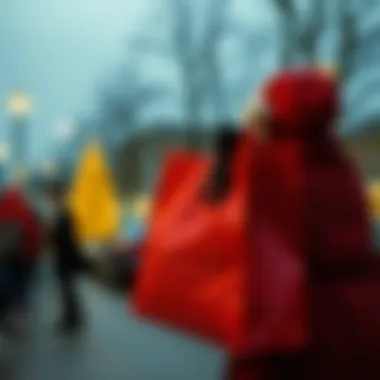The Importance of Christmas Reusable Bags


Intro
As the holiday season approaches, the hustle and bustle of gift-giving comes to life, accompanied by a renewed focus on sustainability. Amidst the rustic charm of Christmas markets and shimmering decorations lie an often-overlooked aspect of gift-wrapping: Christmas reusable bags. These bags combine aesthetic appeal with practical utility, while also serving a greater purpose of environmental conservation. This article delves into the significance of these bags, illuminating their role not only as an eco-friendly alternative to traditional wrapping but also how they encapsulate the spirit of the season.
In our discussion, we'll explore various elements: from current trends in designs and colors to the materials that construct these festive carriers. We'll also highlight how consumer preferences are shifting towards more sustainable practices. By comparing conventional wrapping methods with reusable options, we also hope to inspire readers to consider their own choices in gifting this season. Join us as we unwrap the various layers of significance and utility behind Christmas reusable bags, revealing just how they can transform the gifting experience into a more environmentally responsible endeavor.
Foreword to Christmas Reusable Bags
As we dive into this season of giving, the significance of Christmas reusable bags cannot be overstated. With the proliferation of environmental consciousness, more folks are looking for ways to combine holiday cheer with eco-friendly practices. Christmas reusable bags represent that perfect marriage of practicality and sustainability. These bags not only serve a functional purpose but also stand as a testament to our collective effort to reduce waste.
Definition and Evolution
Christmas reusable bags are specially designed storage solutions that often showcase festive themes related to the holiday season. Over the years, these bags have morphed from basic cloth carriers to vibrant, stylish accessories featuring intricate designs—think snowflakes, holly, and even jolly Santa faces. Originally meant as alternatives to the ubiquitous plastic bags, these carriers now have a life of their own, adapting to contemporary aesthetics and social values. As the materials evolved from simple jute to durable recycled fabrics, the appeal broadened, and so did their utility.
Historical Context and Usage
Historically, during the early days of holiday commerce, gift wrapping focused primarily on convenience. Traditional wrap paper was quite popular, but it came at a cost: heaps of waste that inevitably found its way to landfills after the festivities. As a response, the influx of reusable bags was a breath of fresh air. They emerged not just to replace single-use options but also to redefine how we think about gift-giving. By the turn of the century, their popularity skyrocketed, prompting retailers to offer attractive designs and even personalized options. From bustling Christmas markets in Germany to big-box stores in the United States, reusable bags are quickly becoming the go-to choice for gift carry. In fact, many cities have started to outlaw single-use bags altogether, making the choice for alternatives not only ecological but essential.
Environmental Considerations
Understanding the environmental impact of our holiday practices has become imperative as we strive for sustainability. This section delves into the consequences of packaging choices we face during the festive season, particularly focusing on single-use bags and the noteworthy advantages offered by reusable options. By analyzing these aspects, we can appreciate not only the benefits they bring but also the importance of making informed decisions.
Impact of Single-Use Bags
Single-use plastic bags have become synonymous with convenience, particularly during busy shopping sprees. However, their environmental footprint is heavy and lasting. Did you know that millions of these bags end up in landfills and oceans every year, contributing to pollution and threatening wildlife? The statistics paint a stark picture:
- Approximately 1 trillion plastic bags are used globally each year.
- Only about 1% of those bags are recycled.
This ineffective recycling leads to a scenario where the bags not only clog drains, causing flooding, but also break down into microplastics that persist for centuries. Fish and other sea creatures often ingest these bits, leading to a dangerous ripple effect up the food chain. The consequences are neither trivial nor distant; they echo back to us and alter ecosystems we rely on.
Switching to reusable bags offers a clear antidote to this problem. They are not just a trendy choice—they embody a step toward a more sustainable lifestyle. Imagine heading to a Christmas market, your reusable bag at the ready, embodying both practicality and responsibility.
Benefits of Reusability in Holiday Shopping
The resurgence of reusable bags is not just a fad; it highlights a cultural shift in how we view consumption. Here are several key benefits that come with opting for reusable bags during holiday shopping:
- Reduced Waste: By using a reusable bag, you cut down the demand for single-use plastics, thereby diverting waste from landfills.
- Durability: Unlike flimsy plastic bags that tear easily, many reusable options are crafted from sturdy materials, allowing for multiple uses throughout the season and beyond.
- Style & Personal Statement: During the festive season, reusable bags often come in cheerful designs that can brighten your shopping experience. Personalizing one with family photos or holiday motifs can transform it into a cherished item.
- Economic Sense: While the initial investment might be higher, the long-term savings accumulate as you avoid the constant purchase of new single-use bags.
"Sustainability is no longer an option; it’s a necessity in the evolution of consumer preferences.”
Each of these benefits builds the case for reusability, aligning both our values and actions with a more conscientious way of celebrating. In doing so, we contribute not just to our community, but to the planet at large.
In summary, the environmental considerations surrounding our holiday shopping habits underscore the importance of making mindful choices. As we embrace the season of giving, let’s include giving back to our planet in our practices. This is where Christmas reusable bags come into play, serving as a bridge between festive cheer and ecological consciousness.
Material Composition of Reusable Bags
When it comes to Christmas reusable bags, the materials that compose them play a crucial role in their overall efficacy, durability, and environmental impact. The significance of understanding material composition cannot be overstated; it informs consumers about the longevity of their bags, the environmental footprint of production, and how effectively these bags can fulfill their intended purpose, especially during the bustling holiday shopping season.
Types of Materials Used
The world of reusable bags is a tapestry of various materials, each chosen not only for aesthetic purposes but also for functional attributes. Here's a glance at some of the most common materials in the market:
- Cotton and Canvas: Often hailed as the darling of sustainable materials, cotton bags, particularly those made from organic cotton, offer both breathability and sturdiness. Canvas, a heavier variant, is known to withstand substantial weight and frequent use.
- Polyester: Widely used due to its lightweight nature, polyester bags often feature vibrant prints and designs. This synthetic fabric is durable and can be recycled, yet its production can lead to greater environmental concerns if not sourced responsibly.
- Jute: Made from the jute plant, jute bags give a rustic charm and are fully biodegradable. They are highly durable, making them perfect for carrying hefty loads, which is often the case during shopping sprees.
- Recycled Plastic: Bags made from recycled plastics are gaining traction, positively contributing to reducing plastic waste. They can be sturdy and can hold a good amount of weight but may have a less appealing aesthetic compared to fabric alternatives.
With many options available, consumers can choose based on their style preferences and practical needs.


Sustainability of Different Materials
When considering sustainability, it's essential to delve deeper into the impact of different materials:
- Ecosystem Footprint: The production process of materials plays a significant role in their sustainability. For example, organic cotton is generally cultivated without harmful pesticides, which helps preserve local ecosystems. On the contrary, conventional cotton farming can strain water resources and involve chemicals that detrimentally affect biodiversity.
- End-of-Life Considerations: It’s also important to think about the lifespan of the material after being used. Natural fibers like cotton and jute can decompose, offering a more environmentally friendly end-of-life scenario than synthetic materials, which may linger for centuries in landfills.
- Recyclability and Upcyclability: Reusable bags made from recycled materials, such as PET (from water bottles), present a unique advantage. They contribute to a circular economy by extending the lifecycle of materials. Moreover, many companies are beginning to offer programs to recycle these bags at the end of their use.
Incorporating such awareness of materials not only enhances informed consumer choices but also promotes a culture of sustainability where holiday shopping is aligned with environmental responsibility.
"The difference between a commodity and a gift is not just in how it looks, but in what it represents."
As consumers prioritize eco-friendly choices, the materials chosen for Christmas reusable bags bear not just aesthetic value but profound implications for our planet.
Design and Aesthetic Choices
The design and aesthetic choices of Christmas reusable bags are significant, not just for their practical use during the festive season, but also for their ability to enhance the overall gift-giving experience. As consumers become increasingly aware of sustainability, the appearance of these bags plays a crucial role in their acceptance and preference. An attractive design can transform a simple bag into a statement piece that complements the holiday spirit, reflecting individual taste and making eco-conscious decisions feel more rewarding.
When selecting a bag, shoppers consider a myriad of factors, such as color, print, and style. Seasonal themes often influence these choices, with many gravitating towards vibrant reds, greens, and metallics that resonate with traditional holiday colors. Interestingly, designs that incorporate festive imagery, like snowflakes or Christmas trees, can evoke nostalgia and joy, creating a stronger emotional connection when giving gifts. People want their gift wrapping to convey the cheerful essence of Christmas, and a well-designed reusable bag can do just that while being practical.
Popular Designs for the Holiday Season
Several design trends emerge every holiday season, giving shoppers options that fit various aesthetics. Here are some of the most popular choices:
- Classic Patterns: Stripes, plaids, and polka dots in holiday colors like deep greens and bright reds bring a traditional flair to reusable bags. These patterns often evoke memories of earlier Christmases and add a touch of nostalgia.
- Whimsical Illustrations: Bags adorned with playful designs, such as Santa Claus, reindeer, or snowmen, appeal particularly to families with children. These fun motifs make the bags not just practical but a delight for the younger crowd as well.
- Elegant Minimalism: For those who prefer a sophisticated look, minimalist designs with streamlined colors and subtle detailing can speak volumes. Often featuring muted tones or simple geometric patterns, these bags suit a more refined taste while maintaining a festive spirit.
- Cultural Inspirations: Designs that draw from various cultures and traditions can create a unique holiday experience. Patterns inspired by different holiday celebrations can appeal to a diverse audience, showcasing the season's universal spirit of giving.
Customization and Personalization Options
Customization has become a critical aspect of consumer purchases, particularly when it comes to Christmas reusable bags. Offering unique options allows individuals to express their personality and embrace creativity in their gifting methods. Here are some prevalent ways to customize these bags:
- Name Embroidery: Adding a name or initials to a bag can turn it into a cherished keepsake. This personal touch can be especially meaningful when gifting a bag filled with goodies, making the recipient feel valued.
- Custom Prints: Many companies now offer the ability to create bespoke designs, whether it be a family photo or a cherished quote. This allows shoppers to create bags that reflect their values or commemorate special memories.
- Seasonal Versatility: Certain design companies produce bags that come with interchangeable patches or covers. As a result, a single bag can transition seamlessly from a Christmas design to a more general one for other occasions.
- Eco-Friendly Messages: Personalizing bags with slogans or messages that promote sustainability can resonate with socially-conscious consumers. These bags serve a dual purpose: they are stylish and reminders of environmentally friendly practices.
Ultimately, the design and aesthetic choices of Christmas reusable bags play a critical role in their acceptance and usage. They not only cater to individual preferences but also support a larger mission of sustainability during the holiday season. As consumers increasingly seek options that are both functional and visually appealing, these bags stand out as a responsible alternative to traditional wrapping methods.
Practical Functionality of Reusable Bags
The practicality of reusable bags, especially during the holiday season, cannot be overstated. These bags serve as a bridge between convenience and sustainability, showcasing their utility in various aspects of holiday shopping and gifting. With their durable construction and multifunctionality, reusable bags cater to the needs of consumers who are both value-driven and environmentally conscious.
Capacity and Storage Solutions
When it comes to capacity, reusable bags offer a wealth of options to accommodate a wide variety of items. Unlike traditional gift wrapping, which often restricts the size and shape of the presents, reusable bags can handle larger, bulkier gifts with ease. For instance, a sturdy canvas tote can not only hold multiple gift items but can also support heavier objects like books or wine bottles without the fear of tearing or breaking.
Moreover, many modern reusable bags are designed with organizational features such as compartments or zippered pockets, making it easier to store smaller gifts separately and prevent clutter. This versatility is especially beneficial during busy shopping periods, allowing consumers to pack their gifts efficiently and ensuring that everything is neatly arranged.
- Capacity options:
- Canvas totes for large gifts
- Insulated bags for perishable items
- Smaller pouches for delicate gifts
Versatility Across Different Uses
Beyond holiday gifting, reusable bags are incredibly versatile and can be adapted for a range of purposes throughout the entire year. During the festive season, these bags often double as shopping carriers, party supplies holders, or even as decorative elements. Their robust nature makes them ideal for carrying Christmas treats or handmade goodies to gatherings.
For example, imagine using a seasonal-themed reusable bag not only for wrapping a gift but also for transporting baked goods to a holiday potluck. It adds a touch of festivity while remaining eco-friendly. After the holidays, these bags can transition seamlessly into grocery carriers, beach bags, or school backpacks. The ability to repurpose them reduces waste and promotes a culture of sustainability.
"The beauty of reusable bags lies in their practicality; they adapt to various needs, making them indispensable throughout the year."
In addition, the availability of different designs and materials means that shoppers can select bags that reflect their personal style or the occasion at hand. From bright prints to sophisticated patterns, there's a reusable bag to fit every taste—and even season!
Thus, the practical functionality of reusable bags enhances not only the holiday shopping experience but also contributes to a more sustainable lifestyle well after the holiday cheer has faded.


Consumer Preferences and Trends
In recent years, consumer preferences have undergone a significant transformation regarding sustainability and environmental conservation. Nobody is just buying things willy-nilly anymore. There’s a newfound awareness about how daily choices impact the broader ecosystem. When it comes to holiday shopping, the trend towards eco-friendly options is particularly notable. This shift is more than just a passing phase; it reflects deeper societal values that prioritize environmental responsibility.
Market Growth in Eco-Friendly Products
The market for eco-friendly products has seen an impressive surge. A report from Statista indicates a projected growth in the global market for sustainable products to reach a staggering $150 billion by 2021. This growth is fueled by a combination of factors, including an increasing number of consumers who align their purchasing decisions with their values. It seems that folks are increasingly apt to fork over their hard-earned cash for the assurance that their purchases do not contribute to environmental degradation.
People are looking for products that embody more than just functional qualities; they want them to resonate with a certain ethos. Christmas reusable bags fit this bill perfectly. These bags not only serve the practical function of transporting gifts but also symbolize a commitment to reducing waste and promoting sustainability during the holiday season.
"Choosing eco-friendly options for wrapping and carrying gifts reflects a conscious lifestyle that prioritizes the planet."
Additionally, brands are discovering that consumers expect transparency and authenticity from the products they purchase. They no longer accept obscure sourcing practices or harmful production methods. Brands like Baggu and Reusable Bags have found success by emphasizing their commitment to environmentally-sound materials and processes. This shift means that companies are now not just trying to market a product; they're also selling a narrative that resonates with consumers’ values.
Changing Attitudes Toward Gift Wrapping
Gift wrapping has seen an evolution too. Gone are the days when it was just about throwing some colorful paper around a present. There’s a burgeoning appreciation for the aesthetic and emotional value of how gifts are presented. Many shoppers are recognizing that traditional gift-wrapping methods often result in waste. How many rolls of wrapping paper end up in landfills after the holidays? Quite a bit, to say the least.
Today's consumers are likelier to choose reusable bags over conventional wrapping paper as a statement about their values. The appeal lies in practicality and longevity; a reusable bag doubles as a functional item beyond the holiday season. This shift is also seen in the styles that customers are considering. Many are leaning towards bags that reflect their personality and can be utilized in everyday life, making them more desirable than plain old wrapping paper.
Moreover, personalization options allow consumers to express themselves creatively. Some choose designs that resonate with their holiday spirit, while others opt for customizable bags that carry a unique message or image.
To summarize, consumer preferences are a strong indicator of the path forward. As awareness about sustainability grows, choices like reusable Christmas bags are becoming the norm rather than the exception. It's a pivotal moment for the market, encouraging brands to adapt and innovate in response to consumers' values, ultimately fostering a more eco-conscious culture.
These trends represent a broader shift towards sustainability and show how attitudes toward everyday items can evolve effectively, impacting every holiday shopping list.
Comparative Analysis: Reusable vs Traditional Wrapping
In the midst of holiday shopping, the topic of how to package gifts has gained significant importance. As eco-awareness grows, consumers are faced with the choice between traditional wrapping methods and modern reusable bags. Understanding the implications of these choices can inform not only personal values but also encourage a shift in cultural practices associated with gift-giving during Christmas.
Cost-Effectiveness Over Time
When contemplating the costs involved, the comparison between reusable bags and traditional wrapping paper is particularly striking. Traditional wrapping paper, often seen as a one-time use item, ends up in trash bins rather quickly after the gifts are unwrapped, contributing to landfill waste.
On the other hand, reusable bags, although they might seem more expensive at purchase, provide a far better return on investment over time. A one-time purchase of a sturdy Christmas-themed reusable bag can cover multiple gift-giving seasons. For example, if a family buys four reusable bags costing $10 each, they can use these for several years, saving themselves from spending on new wrapping paper every holiday. It’s like planting a tree – once it has taken root, it continues to yield benefits year after year.
Here’s a breakdown of costs:
- Traditional Wrapping Paper: $3-$5 per roll, often used once.
- Reusable Bags: $10 per bag, usable for multiple years.
This comparison highlights that those willing to embrace reusable bags not only contribute to environmental sustainability, but also save money in the long run. Such a practice doesn't just stop at gifts; these bags can serve many purposes, from grocery shopping to day trips, thus amplifying their utility.
Aesthetic Value and Emotional Appeal
For many, gift-giving is about more than the physical exchange of items; it’s about creating emotions and memories. Traditional wrapping often brings to mind an element of surprise and joy as the recipient tears into the colorful paper. Yet, reusable bags have carved out a niche that elevates both the aesthetic and emotional aspects of gifting.
Consider a beautifully designed, reusable bag adorned with festive patterns that evoke nostalgia. These bags can be part of the gift itself, making the presentation feel more special. Not only does it serve its intended purpose, but it also becomes a cherished item for the recipient, adding to its sentimental value.
Furthermore, choosing a environmentally friendly option like a reusable bag speaks volumes about one’s values. It conveys care not just for the recipient, but also for the planet. This type of thoughtful approach to gifting might evoke an emotional response that traditional wrapping often lacks. When a sender puts extra effort into selecting an aesthetically pleasing and sustainable option, the recipient is likely to appreciate the gift on multiple levels.
As we move toward a more eco-conscious culture, exploring how gifts are presented holds great significance. The shift from traditional wrapping to reusable bags symbolizes broader changes in consumer behavior and attitudes toward sustainability.
"Embracing reusable bags during the holiday season represents a beautiful blend of practicality and emotional connection."
Strategies for Incorporating Reusable Bags
As the holiday season approaches, the charm of Christmas reusable bags blossoms anew. It's not just about eliminating single-use plastic bags; it's about adopting practical strategies for their incorporation into our festive culture. Understanding how to use these bags effectively can make a significant difference in creating a more sustainable environment while dressing our gifts in style.


Selecting Suitable Bags for Different Gifts
When it comes to selecting the right reusable bags for various gifts, the choices can be overwhelming yet delightful. The first step is assessing the size and shape of the gifts you intend to wrap. For smaller items like ornaments or trinkets, opt for bags that are compact and feature festive designs. Many bags come adorned with snowflakes or holly, adding an extra layer of cheer.
For larger gifts, like blankets or kitchen appliances, sturdier and larger bags are essential. Materials like canvas or jute not only provide durability but also add a touch of elegance. Pairing the size with appropriate patterns is key; for example, a sophisticated tartan print complements a classic wine bottle well, making it a thoughtful gift presentation.
Here are some tips on selecting the right reusable bags:
- Assess the Size: Ensure the bag can fit the gift without cramming or bulging.
- Consider the Receiver: Choose designs that reflect the recipient's taste or interests.
- Think Functionality: Some bags have compartments or zippers that enhance usability.
Storing and Organizing Reusable Bags
Once you've chosen your reusable bags, an organized approach to storing them is crucial. Having a clutter-free space can simplify your holiday prep and ensure you always have bags on hand when you need them. Here are some methods to consider:
- Dedicated Storage Space: Designate a specific drawer or bin for all your reusable bags. This keeps them contained and prevents misplacement.
- Roll or Fold Neatly: Rolling bags can save space, while folding them neatly allows for quicker access. Use an elastic band to keep rolled bags intact.
- Labeling: If you're a fan of organization, labeling bags can help. Whether you categorize by size, color, or intended use, this can streamline the decision-making process when looking for a bag.
Incorporating these strategies not only promotes sustainability but also enhances the overall gift-giving experience, making it smoother and more enjoyable.
"A well-organized space reflects a well-organized mind, especially during the bustling holiday period."
When it's all said and done, the push towards Christmas reusable bags is not just about aesthetics; it's a meaningful step toward crafting an eco-friendly tradition that leans towards the brighter side of gift-giving.
Future of Reusable Bags in Holiday Celebrations
The advent of Christmas reusable bags has marked a shift in how we approach holiday gifting and festivities. As the world becomes more environmentally conscious, the future of these bags appears promising. Their significance extends beyond mere aesthetic appeal; they embody a commitment to sustainability that resonates with many consumers today. Shifts in consumer preferences and awareness of environmental issues have made it increasingly important to rethink traditional packaging and the implications they carry.
Innovations in Design and Usage
In the realm of reusable bags, innovation drives change. Companies are now prioritizing design features that don’t just meet functional requirements but also cater to aesthetic sensibilities. This includes using vibrant colors, festive patterns, and even customizable elements that allow individuals to express their holiday cheer creatively. Brands are exploring materials that not only boast durability but also encourage eco-friendliness, such as organic cotton, recycled plastics, and plant-based fabrics.
For instance, a company like Baggu has introduced bags that fold into small pouches, making them portable and easy to carry. This is a far cry from the bulky, cumbersome reusable bags of yesteryear. Furthermore, seasonal collaborations with artists are paving the way for unique designs, turning a simple shopping bag into a statement piece. Imagine a bag that features your favorite Christmas movie characters, making it as much a part of the celebration as the presents inside.
Holistic design perspectives are addressing the full cycle of the product, from production to disposal. By incorporating features like biodegradable materials and designs that facilitate recycling, companies are lowering their carbon footprints while catering to the style-conscious shopper. This innovation is not just beneficial for consumers wanting a trendy bag; it contributes to a broader movement toward responsible consumerism.
Anticipating Consumer Needs Moving Forward
To understand where reusable bags are headed, it’s crucial to consider what consumers will demand in the future. Convenience remains a top priority. As urban living spaces shrink, people might look for bags that are not only functional but also fit seamlessly into their fast-paced lives. For instance, bags with features like straps for easy carrying or pockets for organization will likely gain traction.
In addition to functionality, there's a growing expectation for bags to tell a story or convey a message. Shoppers are leaning towards products that reflect their values—whether it's supporting local artisans or being part of a greater sustainability effort. This opens the door for brands to craft narratives around their products, creating emotional connections with consumers.
Epilogue: Embracing Sustainability
In the festive rush of the holiday season, the significance of Christmas reusable bags transcends mere utility. As societies become more aware of environmental issues, these bags represent a shift in consumer behavior and a step towards sustainability. The growing emphasis on eco-friendliness has ushered in a new perspective on how we wrap and present our gifts. By choosing reusable bags, shoppers are not just making a choice about packaging; they're participating in a broader movement aimed at reducing waste and conserving resources.
While traditional wrapping paper has its charm, it often ends up as trash, contributing to landfill overflow and unnecessary waste. In contrast, reusable bags serve a dual purpose: they offer a stylish way to present gifts while also promoting a sustainable lifestyle. Their durability means they can be used year after year, making them not just a temporary solution but a long-term investment in our planet's health.
Moreover, many reusable bags are crafted from recycled or sustainable materials, further minimizing their environmental footprint. People often overlook the simple yet powerful impact of these choices; a single plastic bag can take hundreds of years to decompose, while a reusable bag can be part of a circular economy that values sustainability.
"Every little effort counts when we’re talking about our environment. Making small changes can lead to significant impacts!"
Thus, as we stop and take stock during the holidays, embracing reusable bags highlights our commitment to a healthier planet. It nudges us towards a culture that values both style and environmental responsibility.
Recap of Key Points
- Environmental Impact: Traditional wrapping paper creates significant waste, while reusable bags help reduce this environmental burden.
- Durability and Versatility: Reusable bags can be utilized across multiple occasions beyond just Christmas, making them a practical choice.
- Aesthetic Appeal: These bags can be stylish and customizable, maintaining the joy connected to gift-giving without compromising sustainability.
- Consumer Responsibility: Choosing reusable bags is an expression of a consumer’s commitment to eco-friendliness.
Call to Action for Eco-Conscious Shoppers
As we navigate the holiday shopping landscape, it's crucial for consumers to think beyond personal choices. Opting for Christmas reusable bags is not just an individual choice; it's a collective movement. Here’s how you can take action:
- Research and Select Quality Bags: Don’t just grab any reusable bag; look for ones made from sustainable materials. Brands like Envirosax or Baggu are worth considering.
- Gift Strategically: Use reusable bags as part of your gift rather than simply a container. This approach adds value and practicality to your present.
- Spread the Word: Engage friends and family on the benefits of reusable bags. Social media platforms like Facebook and Instagram can amplify your message.
- Advocate for Change: Support local businesses and initiatives that prioritize sustainability.
Adopting Christmas reusable bags is a small yet impactful act that lays the groundwork for a more sustainable future. Let this holiday season be a turning point, showing that we can celebrate responsibly without sacrificing the joy of giving.







